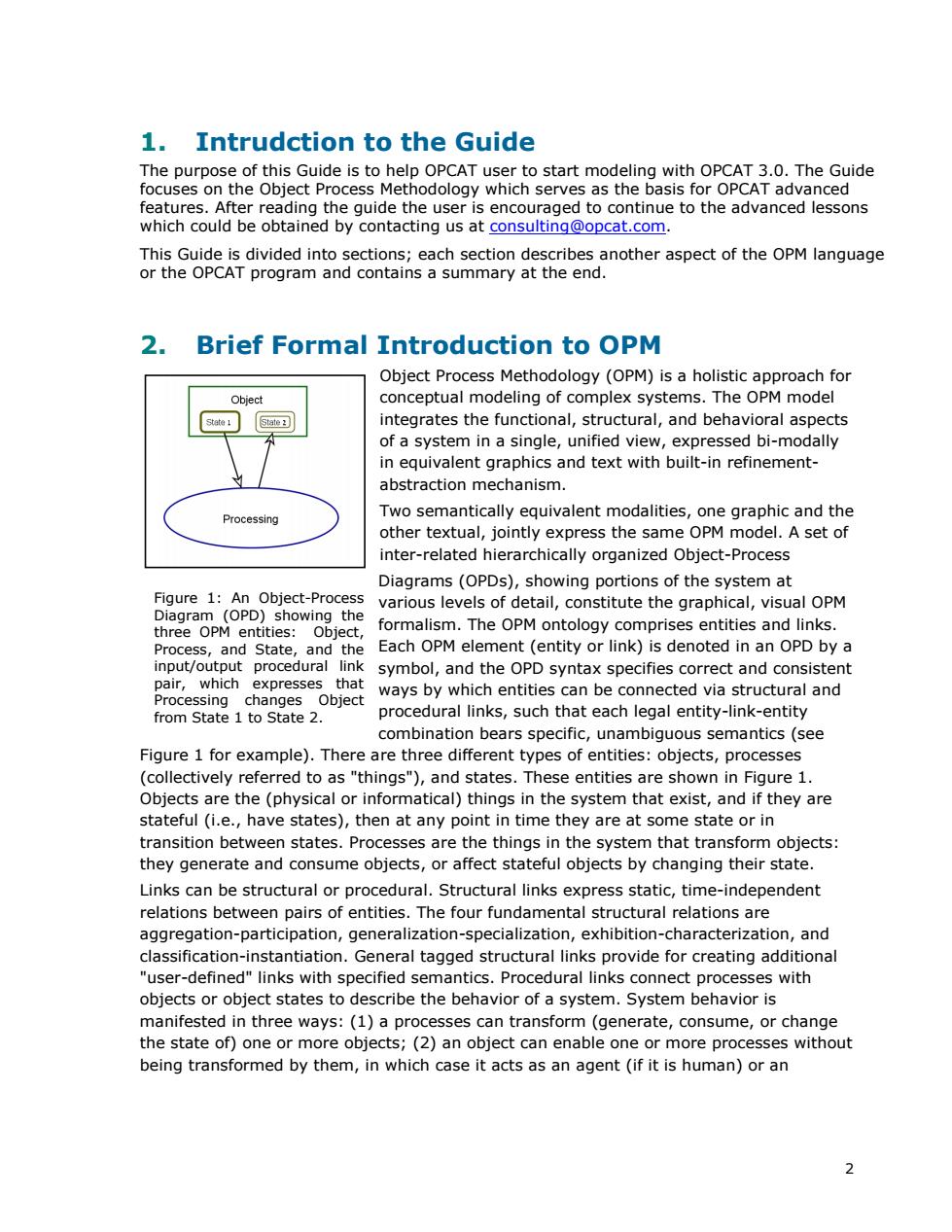正在加载图片...

1.Intrudction to the Guide The purpose of this Guide is to help OPCAT user to start modeling with OPCAT 3.0.The Guide focuses on the Object Process Methodology which serves as the basis for OPCAT advanced features.After reading the guide the user is encouraged to continue to the advanced lessons which could be obtained by contacting us at consulting@opcat.com. This Guide is divided into sections;each section describes another aspect of the OPM language or the OPCAT program and contains a summary at the end. 2. Brief Formal Introduction to OPM Object Process Methodology (OPM)is a holistic approach for Object conceptual modeling of complex systems.The OPM model Stete 1 State 2 integrates the functional,structural,and behavioral aspects of a system in a single,unified view,expressed bi-modally in equivalent graphics and text with built-in refinement- abstraction mechanism. Processing Two semantically equivalent modalities,one graphic and the other textual,jointly express the same OPM model.A set of inter-related hierarchically organized Object-Process Diagrams (OPDs),showing portions of the system at Figure 1:An Object-Process various levels of detail,constitute the graphical,visual OPM Diagram (OPD)showing the three OPM entities:Object, formalism.The OPM ontology comprises entities and links. Process,and State,and the Each OPM element (entity or link)is denoted in an OPD by a input/output procedural link symbol,and the OPD syntax specifies correct and consistent pair,which expresses that Processing changes Object ways by which entities can be connected via structural and from State 1 to State 2. procedural links,such that each legal entity-link-entity combination bears specific,unambiguous semantics(see Figure 1 for example).There are three different types of entities:objects,processes (collectively referred to as "things"),and states.These entities are shown in Figure 1. Objects are the(physical or informatical)things in the system that exist,and if they are stateful(i.e.,have states),then at any point in time they are at some state or in transition between states.Processes are the things in the system that transform objects: they generate and consume objects,or affect stateful objects by changing their state. Links can be structural or procedural.Structural links express static,time-independent relations between pairs of entities.The four fundamental structural relations are aggregation-participation,generalization-specialization,exhibition-characterization,and classification-instantiation.General tagged structural links provide for creating additional "user-defined"links with specified semantics.Procedural links connect processes with objects or object states to describe the behavior of a system.System behavior is manifested in three ways:(1)a processes can transform(generate,consume,or change the state of)one or more objects;(2)an object can enable one or more processes without being transformed by them,in which case it acts as an agent(if it is human)or an 22 1. Intrudction to the Guide The purpose of this Guide is to help OPCAT user to start modeling with OPCAT 3.0. The Guide focuses on the Object Process Methodology which serves as the basis for OPCAT advanced features. After reading the guide the user is encouraged to continue to the advanced lessons which could be obtained by contacting us at consulting@opcat.com. This Guide is divided into sections; each section describes another aspect of the OPM language or the OPCAT program and contains a summary at the end. 2. Brief Formal Introduction to OPM Object Process Methodology (OPM) is a holistic approach for conceptual modeling of complex systems. The OPM model integrates the functional, structural, and behavioral aspects of a system in a single, unified view, expressed bi-modally in equivalent graphics and text with built-in refinementabstraction mechanism. Two semantically equivalent modalities, one graphic and the other textual, jointly express the same OPM model. A set of inter-related hierarchically organized Object-Process Diagrams (OPDs), showing portions of the system at various levels of detail, constitute the graphical, visual OPM formalism. The OPM ontology comprises entities and links. Each OPM element (entity or link) is denoted in an OPD by a symbol, and the OPD syntax specifies correct and consistent ways by which entities can be connected via structural and procedural links, such that each legal entity-link-entity combination bears specific, unambiguous semantics (see Figure 1 for example). There are three different types of entities: objects, processes (collectively referred to as "things"), and states. These entities are shown in Figure 1. Objects are the (physical or informatical) things in the system that exist, and if they are stateful (i.e., have states), then at any point in time they are at some state or in transition between states. Processes are the things in the system that transform objects: they generate and consume objects, or affect stateful objects by changing their state. Links can be structural or procedural. Structural links express static, time-independent relations between pairs of entities. The four fundamental structural relations are aggregation-participation, generalization-specialization, exhibition-characterization, and classification-instantiation. General tagged structural links provide for creating additional "user-defined" links with specified semantics. Procedural links connect processes with objects or object states to describe the behavior of a system. System behavior is manifested in three ways: (1) a processes can transform (generate, consume, or change the state of) one or more objects; (2) an object can enable one or more processes without being transformed by them, in which case it acts as an agent (if it is human) or an Figure 1: An Object-Process Diagram (OPD) showing the three OPM entities: Object, Process, and State, and the input/output procedural link pair, which expresses that Processing changes Object from State 1 to State 2